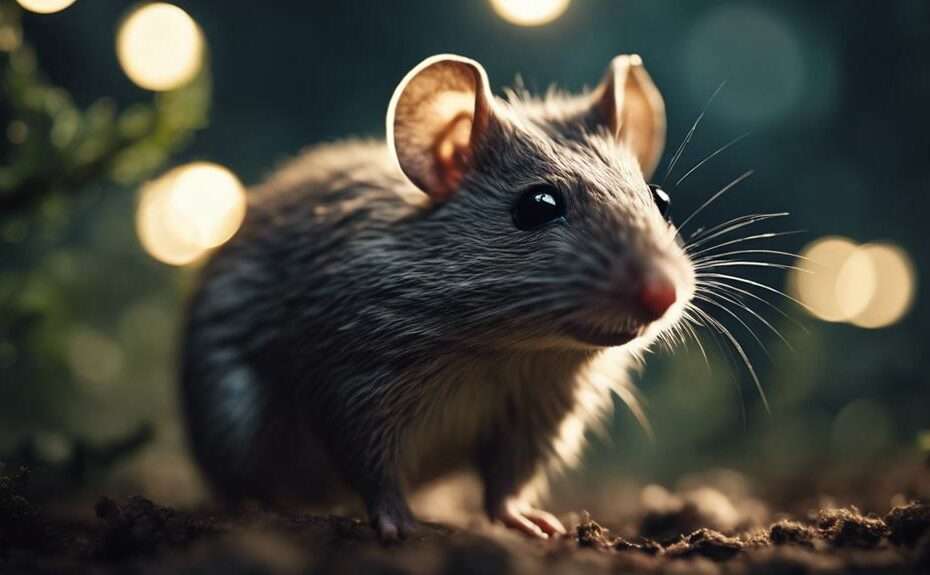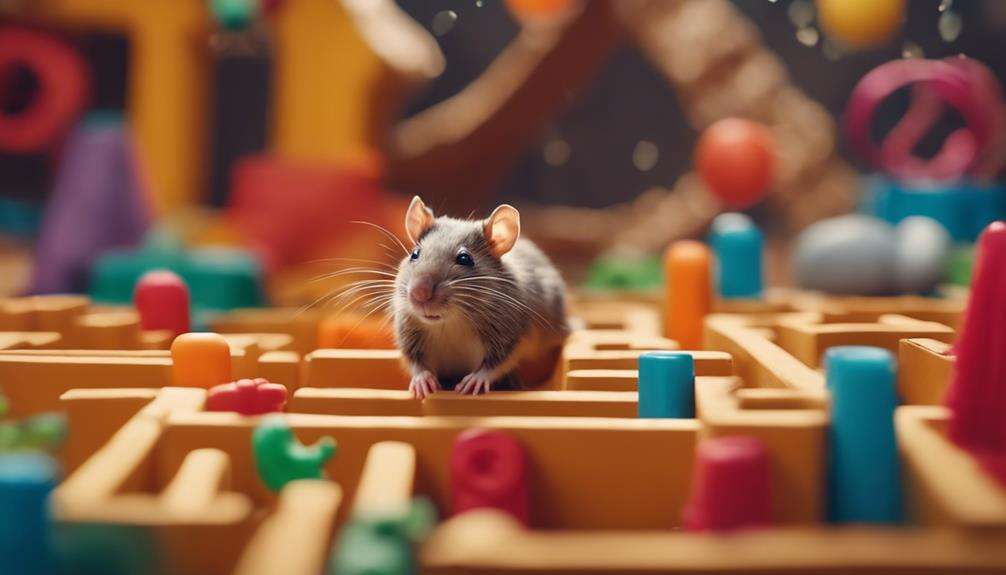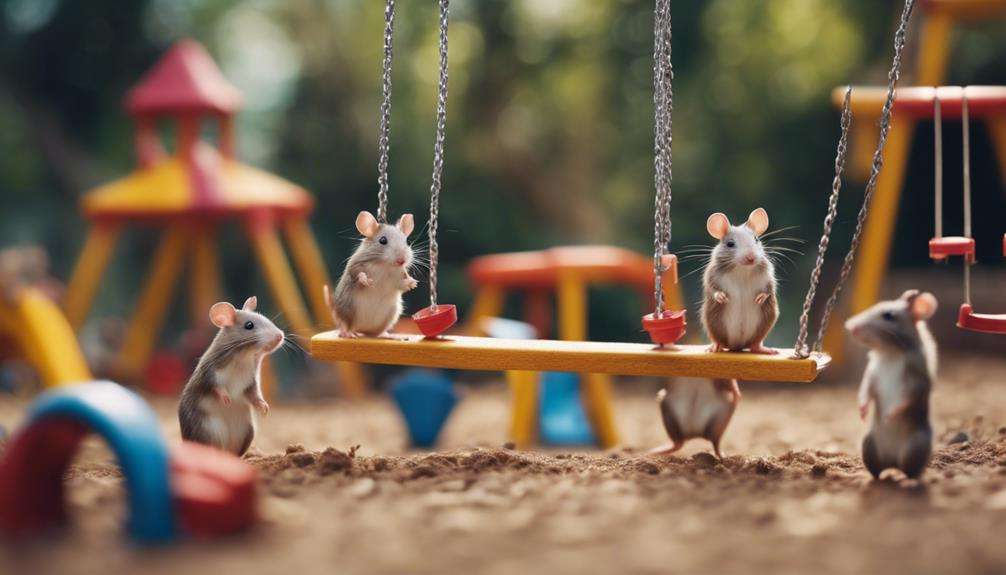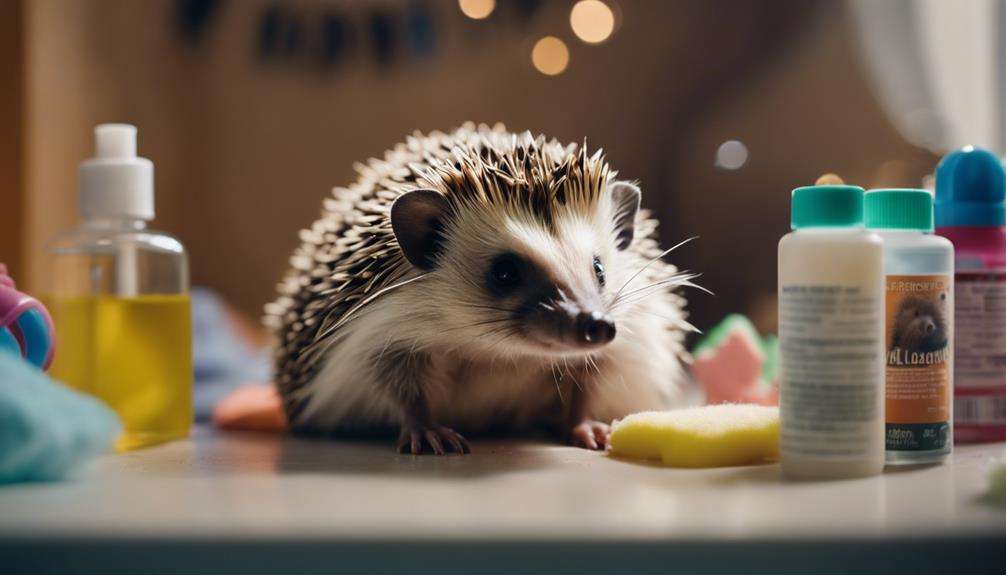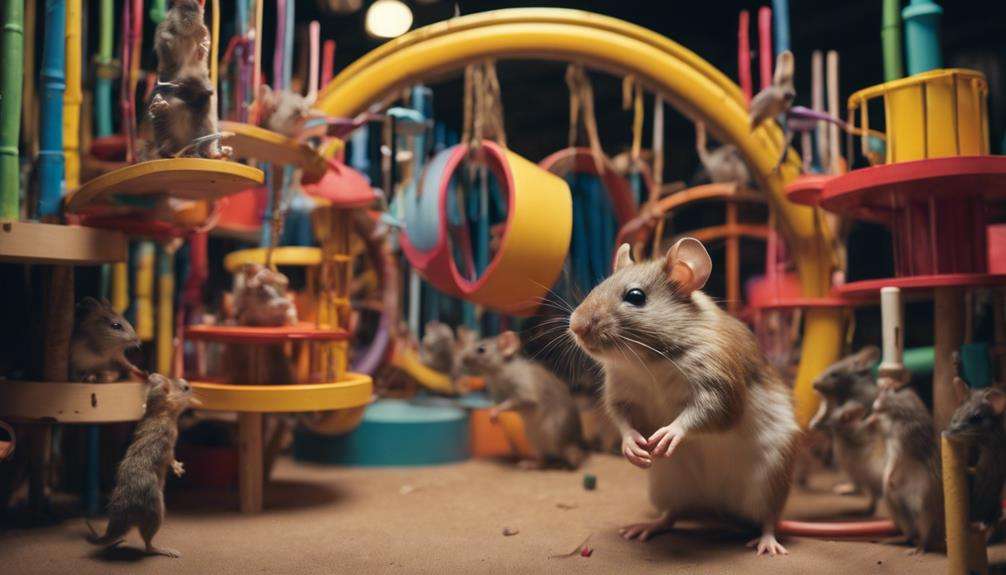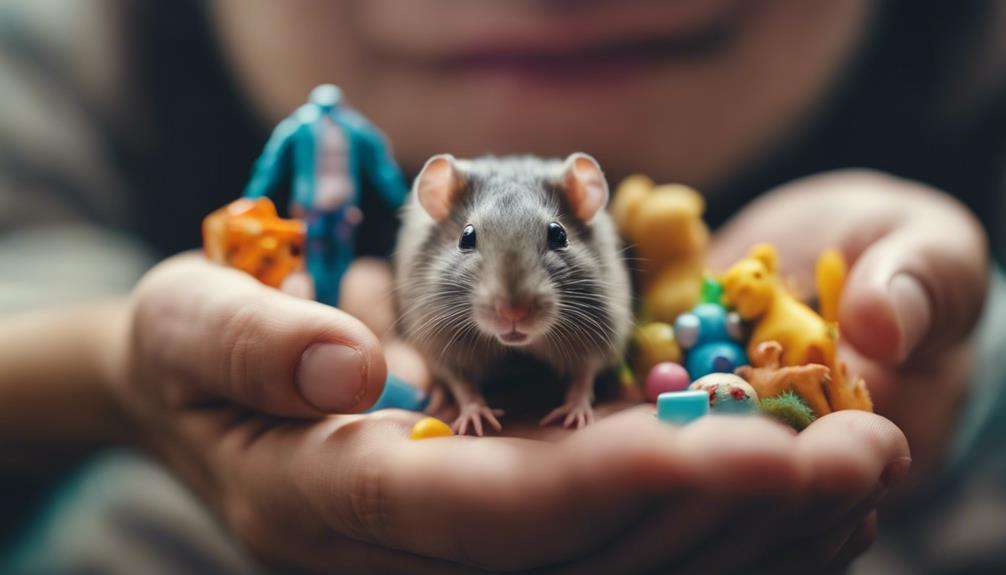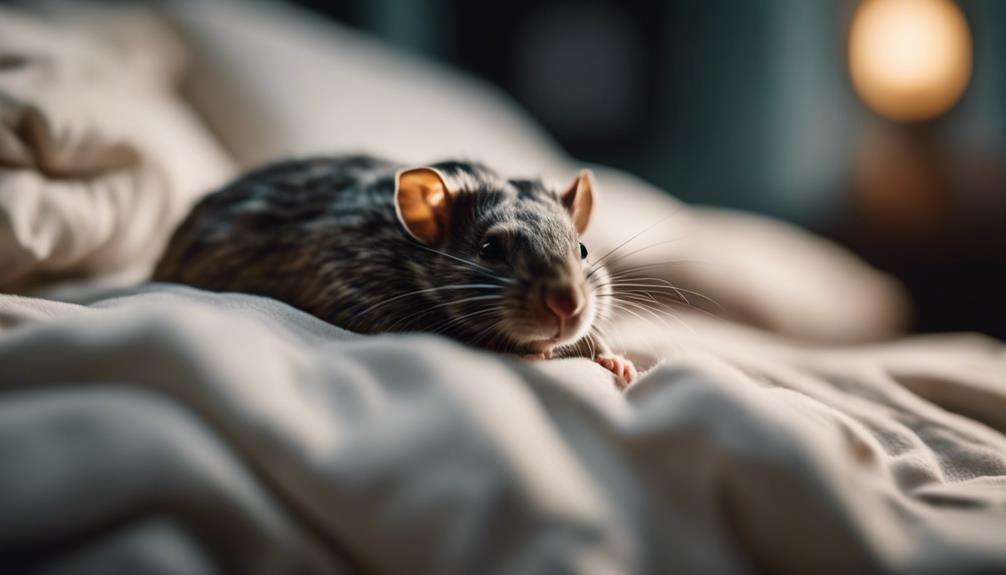As the moon waxes and wanes, a hidden world of quirky rodents comes to life under the cover of the night. Imagine observing these tiny creatures scurrying about in the darkness, their nocturnal habits shrouded in mystery.
What drives these rodents to venture out when most creatures are tucked away in slumber? The enigmatic behaviors of these nighttime dwellers hold secrets waiting to be unraveled, offering a glimpse into a realm rarely seen by the light of day.
Key Takeaways
- Rodents exhibit nocturnal behaviors to avoid predators and conserve energy.
- Foraging efforts peak during late night and dawn, influenced by environmental conditions.
- Polyphasic sleep cycles and unique adaptations aid in survival during the night.
- Twilight antics reflect rodents' ability to synchronize activities with shifting light levels.
Nocturnal Behavior of Quirky Rodents
Quirky rodents, known for their fascinating behaviors, actively engage in nocturnal activities to maximize their survival chances in the wild. By predominantly operating under the cover of darkness, these rodents strategically avoid the prying eyes of diurnal predators that could threaten their existence. Their nocturnal behavior serves as a survival mechanism, allowing them to capitalize on the cooler temperatures of the night for energy conservation while reducing the risk of falling prey to daylight hunters.
These rodents exhibit a pattern of heightened activity during nighttime hours, relying on their heightened senses of hearing, smell, and specialized vision to navigate efficiently in low light conditions. This adaptation enables them to remain concealed during the day, reserving their wakeful moments for when the cover of darkness provides them with a tactical advantage against potential threats.
Despite the challenges posed by limited visibility and the increased risk of predation at night, the nocturnal behavior of quirky rodents plays a crucial role in maintaining ecosystem balance by sustaining other animals through the food they provide.
Rodents' Nighttime Activities Unveiled
You've noticed that rodents, like kangaroo rats, display intriguing activity patterns during the nighttime hours, engaging in foraging behaviors that offer insights into their survival strategies.
Their sleep patterns, such as the polyphasic sleep observed in rats, have been meticulously analyzed to understand how these creatures adapt to their nocturnal lifestyle.
Through research, it has become evident that the nighttime activities of rodents play a crucial role in regulating their body temperature and maintaining the delicate balance of ecosystems they inhabit.
Activity Patterns Discovered
The nocturnal activity patterns of kangaroo rats have been illuminated through detailed behavioral observations and accelerometry data analysis, shedding light on their foraging efforts and active periods.
- Kangaroo rats exhibit increased foraging effort on humid nights, showcasing their adaptability to different environmental conditions.
- Activity peaks for kangaroo rats are observed during late night, morning twilight, and dawn, indicating their strategic timing for resource acquisition.
- Moonlight doesn't reduce kangaroo rat activity, revealing their resilience and ability to thrive even under varying light conditions.
These findings highlight the intricate nocturnal behaviors of kangaroo rats, emphasizing their remarkable adaptability and specialized strategies for survival in their habitat.
Foraging Behavior Insights
Unveiling the nocturnal foraging behavior of rodents provides crucial insights into their adaptive strategies and resource acquisition techniques, shedding light on their efficient utilization of nighttime resources.
Nocturnal rodents, like kangaroo rats, adjust their foraging efforts based on environmental conditions, showing increased activity on humid nights. Their activity peaks during late night, morning twilight, and dawn hours, indicating specific foraging patterns.
Interestingly, moonlight doesn't deter kangaroo rats' activity, demonstrating their lunarphilic behavior. However, these rodents may modify their foraging behaviors to minimize moonlight exposure on brighter nights.
The use of accelerometry data complements behavioral observations, offering detailed information on nocturnal rodents' foraging behavior and enhancing our understanding of their nighttime activities.
Sleep Patterns Analyzed
As we shift our focus towards analyzing the sleep patterns of rodents, particularly their nighttime activities, it becomes evident that these creatures exhibit complex polyphasic sleep cycles that play a crucial role in their adaptation to their nocturnal lifestyle.
- Rodents like kangaroo rats display distinct stages of sleep, including light, deep, and REM sleep, aiding in their survival during the night.
- Their ability to have brief periods of wakefulness interspersed with longer rest periods allows them to remain active during the night while still getting necessary rest.
- Circadian rhythms in rodents are finely tuned to their nocturnal behavior, enabling them to adjust their sleep patterns based on environmental factors such as light exposure, ultimately affecting their overall well-being.
Unique Sleep Patterns of Rodents
Rodents, such as rats, display fascinating sleep patterns characterized by polyphasic cycles that include light, deep, and REM sleep stages. These distinct sleep phases enable rodents to achieve restorative rest and engage in cognitive processing essential for their survival.
Rodent Sleep Cycles
During their nocturnal activities, rodents exhibit unique sleep patterns characterized by distinct phases of light, deep, and REM sleep, interspersed with brief wakeful periods.
- Rodents are polyphasic sleepers, transitioning through various sleep stages in a cyclical manner to adapt to their nocturnal lifestyle efficiently.
- Their sleep patterns involve short intervals of wakefulness, allowing them to remain vigilant for potential threats while conserving energy during rest.
- Nocturnal behaviors in rodents play a crucial role in regulating their body temperature, ensuring optimal physiological functions during nighttime hours.
These sleep cycles reflect the adaptive nature of rodents to thrive in their nighttime habitats, highlighting the intricate balance between rest and alertness in their daily lives.
REM Sleep Comparison
Comparing REM sleep patterns between rodents and humans reveals intriguing similarities and differences in their nocturnal behaviors and cognitive processes. Rodents, as nocturnal mammals, exhibit REM sleep characterized by muscle paralysis, rapid eye movements, and heightened brain activity akin to humans. This phase plays a vital role in memory consolidation, learning processes, and emotional regulation for both species.
Unlike humans who've longer REM cycles, rodents experience multiple shorter REM phases throughout their sleep period, each lasting seconds to minutes. Studying REM sleep in rodents provides valuable insights into the sleep patterns of different animal species, shedding light on the variations and commonalities in their neural mechanisms and cognitive functions during this crucial stage of rest.
Quirky Rodents' Adaptations to Darkness
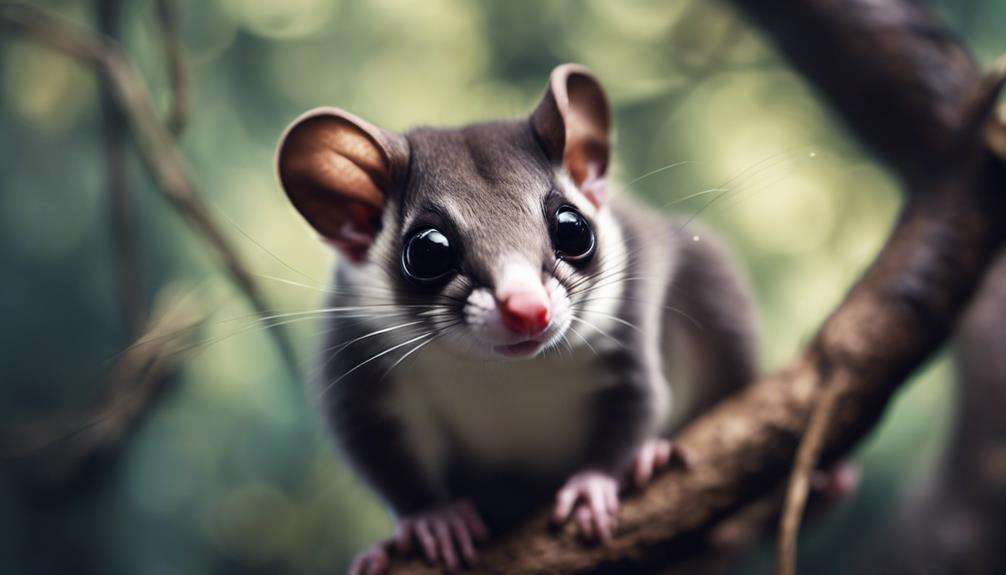
In the dim of night, quirky rodents unveil a myriad of adaptations that equip them for a thriving existence in darkness. These biologically relevant adjustments allow them to navigate the moonlit landscape with finesse and efficiency.
Adaptations to Darkness:
- Enhanced Senses: Nocturnal rodents rely heavily on their acute hearing and heightened sense of smell to forage for food and detect danger in the darkness. These heightened senses help them navigate their environment with precision even under the cover of night.
- Specialized Vision: Rodents have evolved specialized vision adaptations that enable them to see in low light conditions. This enhanced visual acuity aids in their nocturnal activities, allowing them to spot food sources and potential threats in the dark.
- Camouflage: Many rodents have developed camouflage mechanisms to blend seamlessly into their nighttime surroundings, making it easier for them to evade predators and hunt for food without being detected. This adaptation is crucial for their survival in the darkness of night.
Secrets of Rodents' Night Vision
Rodents' night vision holds intriguing secrets, unveiling a complex interplay of specialized adaptations for thriving in low-light environments. Nocturnal rodents have evolved remarkable features to enhance their vision during the dark hours. Their large eyes with wide pupils serve to maximize light intake, allowing them to gather as much light as possible in dim conditions. Additionally, the tapetum, a reflective layer behind the retina, plays a crucial role in improving their night vision by reflecting light back onto rod cells, thus boosting sensitivity.
Moreover, rodents possess rod cells in their retinas with unique DNA packing, enabling them to efficiently capture and process light in the darkness. These adaptations are essential for their survival, as they rely heavily on their vision to navigate their surroundings and locate food during the night. Despite their exceptional night vision, rodents also utilize heightened senses of hearing and smell to complement their visual capabilities, showcasing their multifaceted strategies for thriving in low-light environments.
Rodents' Nocturnal Foraging Habits
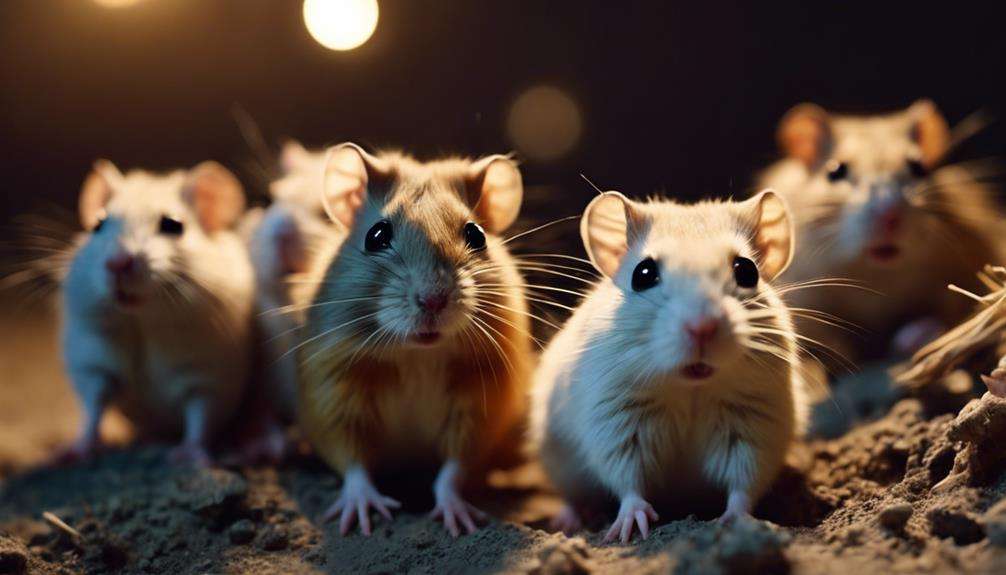
During the dark hours, nocturnal rodents exhibit distinct patterns in their foraging behaviors, revealing intriguing insights into their adaptive strategies for survival.
- Humid Nights: Rodents show increased foraging efforts on humid nights, actively searching for food sources to meet their dietary needs.
- Optimal Activity Peaks: Rodents tend to peak in activity during late night, morning twilight, and dawn, aligning with optimal foraging opportunities when food sources are more readily available.
- Lunar Adaptability: Contrary to common belief, moonlight doesn't hinder rodent activity; instead, these creatures demonstrate adaptability to various light conditions, showcasing a preference for foraging under moonlit nights.
Research on rodent foraging habits has revealed their intricate relationship with environmental cues, highlighting their ability to adjust their behaviors based on factors like humidity and moonlight. This adaptability not only aids in their survival but also underscores the complexity of their nocturnal activities.
Accelerometry data has been instrumental in providing detailed insights into the nuanced foraging behaviors of these quirky rodents, shedding light on their fascinating nighttime routines.
Exploring Rodents' Nighttime World
As you observe the nighttime world of rodents, their behaviors come to light in intriguing ways. These creatures demonstrate a unique set of adaptations tailored for darkness, enhancing their hunting and foraging activities.
Technological tools like accelerometers offer a glimpse into the dynamic and strategic movements of these quirky rodents as they navigate their nocturnal world.
Rodents' Nocturnal Behavior
In the realm of nocturnal wildlife, the behavior of rodents under the cover of night unveils a fascinating world of adaptability and survival strategies. Rodents are active during the night to avoid predators and regulate their body temperature effectively. Their nocturnal lifestyle isn't just about staying hidden; it also involves intricate circadian rhythms that ensure they're alert and ready to respond to any potential threats.
Rodents' polyphasic sleep patterns, including light, deep, and REM stages, contribute to their ability to rest optimally while staying vigilant. This nocturnal activity isn't just about the rodents themselves; it also plays a crucial role in maintaining ecosystem balance by providing a source of food for other creatures during the dark hours.
Adaptations for Darkness
Rodents, with their heightened senses and specialized adaptations, navigate the darkness of night with remarkable efficiency, showcasing a world of nocturnal strategies that ensure their survival in the face of potential predators. These creatures possess vision adaptations that allow them to see in low light conditions, aiding in their nocturnal activities like foraging and predator avoidance.
By utilizing their enhanced senses of hearing and smell, rodents can navigate and locate food sources during the night, enhancing their chances of survival. Additionally, their ability to blend into the nocturnal environment through camouflage provides them with a layer of protection against predators.
Rodents' efficient energy storage mechanisms further support their nighttime lifestyle by helping them sustain activities when resources are scarce, while behavioral adaptations like minimizing daylight exposure contribute to their successful nocturnal habits.
Hunting and Foraging
Navigating the darkness of night, nocturnal rodents like kangaroo rats exhibit peak activity levels during late night, morning twilight, and dawn, showcasing their prowess in hunting and foraging in the cover of darkness.
Here are some intriguing insights into their nighttime activities:
- Rodents, including kangaroo rats, may increase foraging efforts on humid nights, demonstrating their adaptability to varying environmental conditions.
- Moonlight doesn't deter kangaroo rats from being active, displaying lunarphilic behavior in these creatures.
- Bright moonlight can heighten the predation risk for rodents from visual predators like owls, influencing their hunting and foraging strategies to seek out areas with more cover for protection.
Rodents' Response to Moonlight
Under the luminous glow of the moon, nocturnal rodents exhibit adaptive behaviors in response to the increased predation risk posed by visual predators like owls. Moonlight serves as a predation risk cue for creatures such as kangaroo rats, signaling the presence of potential threats in the darkness.
Bright moonlight conditions heighten the vulnerability of these rodents to visual predators, leading them to alter their foraging patterns to reduce exposure to the moon's illumination on such nights. Rodents, including kangaroo rats, exhibit moonlight avoidance behaviors by shifting their activities to areas with more cover and displaying increased vigilance while foraging.
It's suggested that kangaroo rats, with their specialized traits, may have evolved specific mechanisms that prompt them to avoid moonlit areas to minimize the risk of predation. This strategic response to moonlight highlights the intricate ways in which nocturnal rodents adapt to survive in their natural habitats, where the moon's glow can both guide and threaten their existence.
Uncovering Rodents' Hidden Behaviors
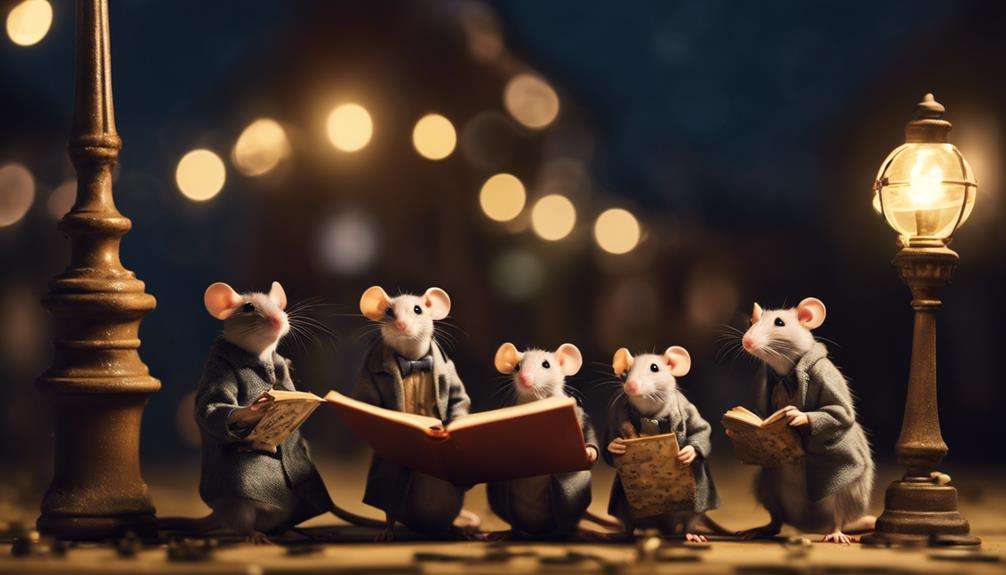
Unveiling the hidden behaviors of nocturnal rodents reveals a complex tapestry of adaptive strategies designed for survival in the darkness. These creatures have evolved fascinating ways to thrive in their nighttime habitats:
- Polyphasic Sleep Patterns: Nocturnal rodents exhibit intricate sleep patterns involving multiple phases, allowing them to remain alert during the darkness and conserve energy efficiently.
- Enhanced Senses and Specialized Vision: To navigate their environment in low-light conditions, nocturnal rodents have developed heightened senses and specialized vision that enable them to detect predators and locate food sources effectively.
- Energy-Efficient Behaviors: Rodents have adapted behaviors that maximize their energy reserves during the night, such as foraging in specific patterns to minimize exposure to potential dangers while still meeting their nutritional needs.
Through these behaviors and adaptations, nocturnal rodents demonstrate a remarkable ability to not only survive but also thrive in the challenging conditions of the nighttime world.
Rodents' Twilight Antics
During the twilight hours, rodents display heightened foraging activity, showcasing their adaptability to changing light conditions and environmental cues. Kangaroo rats, known for their nocturnal behavior, are particularly active during late night, morning twilight, and dawn. Surprisingly, moonlight doesn't deter these creatures; instead, they exhibit lunarphilic behavior, continuing their foraging antics even under the moon's glow.
Studies utilizing accelerometry data have confirmed the behavioral patterns of rodents during twilight hours. These creatures seem to synchronize their activities with the shifting light levels, indicating a sophisticated internal clock that guides their foraging behavior. The twilight antics of rodents aren't solely dictated by external factors like moonlight but are also intricately linked to their inherent nocturnal behavior cycles.
This insight into rodents' behavior sheds light on their remarkable ability to thrive in varied light conditions and adapt their foraging habits accordingly. By studying their twilight antics, researchers can gain a deeper understanding of the complex interplay between environmental cues and animal behavior.
Frequently Asked Questions
What Are Some Interesting Facts About Nocturnal Animals?
Nocturnal animals display unique behaviors like altered sleep patterns, specialized hunting techniques, and distinct communication methods. Their ability to thrive in the dark showcases evolutionary adaptations that enhance their survival in the nighttime environment.
What Rodents Are Primarily Nocturnal?
You might notice that kangaroo rats, pocket mice, and desert mice are primarily nocturnal. Their sleep patterns and behavior adapt to the night. These rodents exhibit unique hunting strategies, communication methods, and mating behaviors under the cover of darkness.
What Are the Adaptations Seen in Nocturnal Animals?
In the dark of night, nocturnal animals showcase remarkable adaptations. Their behavior changes to suit the darkness, employing keen night vision, camouflage tactics, and efficient energy storage. These features aid their survival and success in the nighttime realm.
What Is the Unique Character of Rodents?
In rodents, nocturnal habits are prevalent. Their unique traits include playfulness, heightened senses, and camouflage. Rodent behavior at night involves frequent sleep phases. Adapting to nighttime activities, they exhibit vigilance and rest in cycles, like rats sleeping about 12 hours.
Conclusion
As you peer into the nocturnal world of quirky rodents, you witness a dance of shadows and light, a delicate balance of adaptation and survival. These small creatures navigate the darkness with grace and precision, revealing secrets of the night in their twilight antics.
Their response to moonlight is a symphony of instinct and intelligence, showcasing the beauty of nature's design. Embrace the mystery of the nighttime world, where quirky rodents reign supreme in their lunarphilic kingdom.
